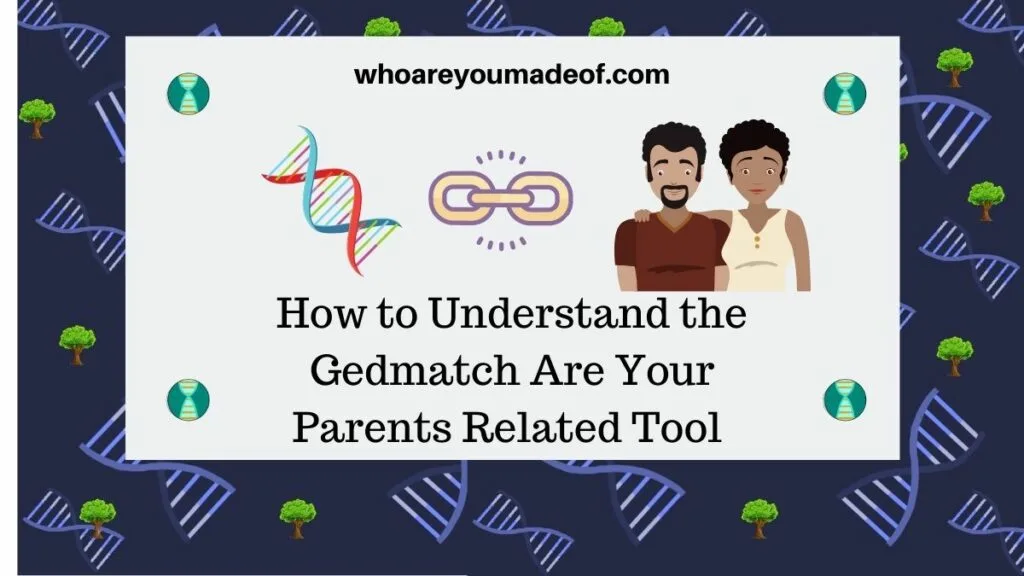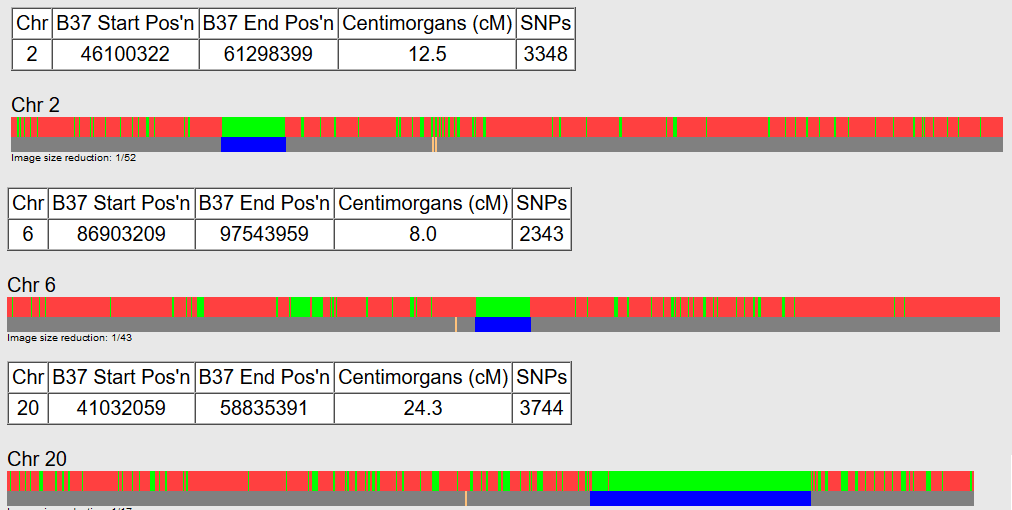Do you want to find out how to know if your parents are related? In this post, find out how to use and understand the Gedmatch Are Your Parents Related Tool results.
This article will show you:
- How to tell if your parents are related
- An example of results from this tool for someone whose parents are related
- An example of results for someone whose parents are likely not related

When I first saw the "Are Your Parents Related" tool, I thought it was cute, and I ran my DNA through it out of curiosity. I was pretty sure that my parents weren't related, though.
I had been doing family tree research for quite a while and had seen no evidence that their lines overlapped in recent history.
However, I now know that it's not that uncommon for parents to be distantly related to each other. This is especially true if they both have common ancestral origins.
Both of my parents have ancestors from Germany, Poland, and the UK.
After years of helping family and friends work through their DNA results, learning about chromosome browsers and even chromosome mapping, I realized that this tool can provide very useful information to people whose parents share ancestry.
How to tell if your parents are related using DNA
Your parents are most likely to be related - even distantly - if they share common ancestral origins. Additionally, people who descend from endogamous communities will also be more likely to find that their parents share common ancestors.
If you have done a DNA test, you can upload your DNA to Gedmatch and run your DNA through the "Are Your Parents Related" tool. If your DNA is already on Gedmatch, you can access this tool from your main Gedmatch home screen.
The only information that you need is your kit number, which you can find directly on your Gedmatch dashboard.
How can the "Are Your Parents Related" tool tell you whether your parents are likely related?
Each human has 22 non-sex chromosomes, and we inherit one recombined copy of each chromosome from both of our parents. The "Are Your Parents Related" tool examines each of our chromosomes (in literally seconds) to see if there are "fully identical regions" where both copies of a chromosome match.
If there are areas on your chromosome where both copies of the chromosome match as a fully identical region, there is a possibility that both of your parents inherited that particular DNA segment from one of the ancestors that they share in common. The larger the fully identical region, the higher the possibility is that this occurred.
You can also estimate the distance to the most recent common ancestor using the size of the largest fully identical region to estimate how far back your parents' common ancestor might be.
Note: If both of your parents have done DNA tests, you don't need to use this Gedmatch tool. Instead, you can use the Gedmatch One-to-One tool to see if your parents share matching DNA segments.
Example of How Are Your Parents Related Results on Gedmatch for someone whose parents are related
In order to illustrate for you the concept of fully identical regions in someone's DNA where both copies of the same chromosome have matching SNPs, I will walk you through the following results from the "Are Your Parents Related" tool.
There was a high likelihood that this individual's parents share a several common ancestor based on their ancestral roots, and they were not surprised to learn that their parents likely share at least one recent common ancestor:

In the image above, you might notice that I included information from Chromosome 2, 6, and 20. This is where this tool spotted identical regions on this individual's chromosomes.
In other words, regions where the copy of the chromosome this person inherited from each of his parents is identical.
(The tool includes images from ALL 22 chromosomes, but I cut most of these out to save space in this post and only displayed those where full identical regions were found)
For each chromosome, you should see a colored bar below the number of the chromosome. The most prominent color on most people's results will likely be the pinkish color.
Regions of the chromosome that are shown in pink are areas where both copies of the chromosome don't match.
You should see the Chromosome number, the start and end position, the number of centimorgans (cMs) indicating fully identical segment length, and SNPs tested. This information is only shown for segments that are longer than 7 cMs in length, since smaller segments are more likely to be identical-by-state instead of identical by descent.
Let's take a closer look at the matching segment on Chromosome 20:

Do you see the solid green bar? This is the location of a fully identical region greater than 7 cM. The information in the table next to the colored bar indicates that this region is 24.3 cMs in length.
There are also several other smaller fully identical regions shown in all of those smaller green bars, but since these are all smaller than 7 cMs in length, they are likely coincidentally identical or so small that they were likely inherited from common ancestors many, many, many generations ago.
The blue bar in the image simply indicates that the segment is longer than 7 cMs in length.
At the end of the results a message appears that confirms our conclusion: "This analysis indicates that your parents may be distantly related." This person has a total of 44.8 centimorgans that match on both sides of his chromosomes, indicating that his parents were likely related at a third cousin distance or further.
Family tree research has confirmed a shared surname between the two parents. Both parents share a great-grandmother with the same last name, which could mean that the most recent common ancestor between this person's parents is as recent as a great-great parent.
Example of How Are Your Parents Related Results on Gedmatch for someone whose parents are NOT related
Many people will not find evidence that their parents have common ancestors within the past few hundred years, which is the general range of autosomal DNA testing.
The image below is from the results of a person whose parents have very different recent ancestry and for whom I have not been able to detect any common ancestors within the past 8-10 generations:

As you can see, most of the bars under the chromosome numbers are pink. There are very, very small (tiny!) green bars which indicate fully identical regions, but since these are so very small, it is exceptionally unlikely (though, not impossible) that these segments were inherited by this individual's parents from the same ancestor.
Conclusion
I hope that this post has been interesting, and that it helped you understand more about the Gedmatch "Are Your Parents Related?" tool. If you have any questions, or if you would like to share your own experience with this tool, I would love to heard from you in the discussion below.
Thanks for stopping by today!


Jim Ward
Tuesday 20th of August 2024
My parents were related to each other twice, but I established that via lineage. The GEDmatch feature didn't think so but that's probably because the connections were too far back. Link 1 is from 2 brothers, sons of 8th great grandparents in Colonial CT.
Link 2 has multiple connections to Robert Royce and Mary Jackson, also in Colonial CT. Five of Robert and Mary's female descendants and 4 of the couple's male descendants are in the mix, including one of their sons who had 2 wives - one in each of my lines. Robert & Mary are 10th maternal and 9th paternal great grandparents. It's wonderfully complicated. :) I'm sure my parents never knew they were distant cousins.
S.M.
Tuesday 13th of February 2024
when i uploaded my dna to gedmatch. it shows that the largest segment is 86.5 with the longest segment 674.7. how can i tell exactly how the two are related?
RL
Tuesday 26th of July 2022
I knew something was up when I found out my dad isn’t my dad and then my Mom’s uncle came across in a family tree that he is my great grandfather. My grandfather and he are brothers. Just did this and my totals are 89.7 the longest segment and the total is 308.9 cm. First cousins? I’m devastated.
Nichole
Sunday 26th of June 2022
The tool indicated the person I am helping has parents distantly related. Largest segment = 11.9 cM Total of segments > 7 cM = 11.9 cM.
How far back would the parents be related?
Mercedes
Sunday 26th of June 2022
Hi Nichole, When we use the tool, we can use the number of shared centimorgans with the same general guidelines that we would if we were just examining two separate people who share DNA at that level. The only thing to keep in mind is that we are only looking at 50% of the total DNA of each parent, so there could be a little more shared DNA that wasn't passed down to the child. Regardless, the parents are distantly related and not likely more closely related than a third cousin a few times removed (i.e. they belong to different generations descending from the common ancestor), and could be as distantly related as 6th-8th cousins (or even more distant). Best of luck to you! Sincerely, Mercedes
Colleen
Tuesday 11th of January 2022
What does it mean if one of your chromosomes have a large chunk but the rest do not? And if you know there are two common surnames on both sides?
Mercedes
Friday 21st of January 2022
Hi Colleen, If there is one large segment on one chromosome that matches on both sides, indicating a relationship between your parents, we could treat the segment as we would a single shared segment of that size between two separate individuals who share that amount of DNA in order to estimate the relationship between the parents. If there is a known shared surname in the trees of both parents, that's a clue about where to start looking for a relationship - but if it is a very popular surname (like "Smith", for example), it is equally possible that there is a shared ancestor on a different line of the tree. Best of luck to you!